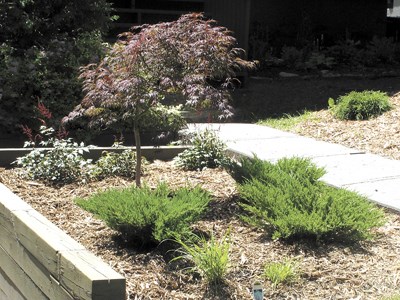A gardener who is anxious to protect a more sensitive or demanding variety never welcomes fluctuating temperatures.
This month alone, I’ve wrung my hands together wishing I had done more to protect my Japanese Maple, and when I do rush out to do so, I’m met with above-seasonal balmy temperatures.
It’s driving me mad, this not knowing.
Living in the North means that certain kinds of plants don’t do well. They’re like that southern Ontario cousin who can’t imagine life out of the city, but, lo and behold, once arrived, finds the fresh northern air something irreplaceable.
When I purchased the expensive tree, I had many raised eyebrows and tsk-tsking from naysayers who thought I should have bought a sand cherry: “A vigorous northern grower, and red to boot.”
But I imagined sculpture. I wanted a fine silhouette to juxtapose the robust blue spruce that stands 75 feet tall. A sand cherry grows wantonly, while a Japanese Maple appreciates form. It’s stylish.
If you want style you pay for it, and so it became my fall duty to protect my investment. First sign of frost and I am rushing to buy, not only burlap, but the alternative to: a felt bolt that boasts “superiority” to burlap.
So I set out to knitting a gigantic mitten to cover my lovely tree. A week of cold weather was approaching and I wanted to be prepared. I placed the mitten gingerly over the branches and watched as that cold weather came. And went. Suddenly the weather was above seasonal.
My colleague, Joanne, herself a master gardener, laughed at my pre-emptive attempts. “Are you building a mouse hotel? Take that mitten off and wait until the ground is good and frozen.”
Mice, right.
They’ll burrow under those leaves and find nourishment on the trunk and bark. So I removed the mitten to find that the leaves (had I mentioned they had not yet fallen?) had turned a gorgeous red that I would have missed if I hadn’t taken Joanne’s advice.
It would be another few weeks before the winter weather threatened and so I enjoyed the tree. Then, the frost hit and this time for a good week straight, but I had failed to protect the tree.
The first free moment, I set out to re-sewing the mitt, and attaching it with twine to bamboo. Taking Joanne’s advice, before I sewed the top of the mitt shut, I filled it with leaves for extra insulation.
I felt heroic. I felt like this tree would make it.
“You covered it already?” was Joanne’s bemused reply. “Too soon, too soon.”
Again? This was like the time when my son was young and I wondered: When can he have a bath by himself? When can he take on a paper route? At what point can he walk to his friend’s house without supervision? There are no rules!
How was I to know that my mittened maple was a signifier of my inexperience? I felt like a helicopter gardener circling aimlessly and anxiously. It was time to let go.
The tree is still mittened, mainly because I can’t bear to sew the felt again.
I’ll have to take my chances with the mice and cross my fingers that I see her bloom come spring.
Anne Boulton is an avid gardener who lives in Sudbury. Visit her blog at greenboots.ca or contact her at [email protected].
Join Sudbury.com+
- Messages
- Post a Listing
- Your Listings
- Your Profile
- Your Subscriptions
- Your Likes
- Your Business
- Support Local News
- Payment History
Sudbury.com+ members
Already a +member?
Not a +member?
Sign up for a Sudbury.com+ account for instant access to upcoming contests, local offers, auctions and so much more.
